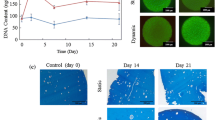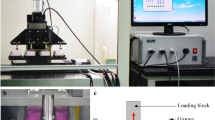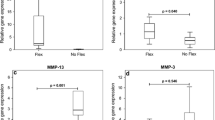Abstract
We have investigated the influence of long-term confined dynamic compression and surface motion under low oxygen tension on tissue-engineered cell-scaffold constructs. Porous polyurethane scaffolds (8 mm × 4 mm) were seeded with bovine articular chondrocytes and cultured under normoxic (21% O2) or hypoxic (5% O2) conditions for up to 4 weeks. By means of our joint-simulating bioreactor, cyclic axial compression (10–20%; 0.5 Hz) was applied for 1 h daily with a ceramic ball, which simultaneously oscillated over the construct surface (±25°; 0.5 Hz). Culture under reduced oxygen tension resulted in an increase in mRNA levels of type II collagen and aggrecan, whereas the expression of type I collagen was down-regulated at early time points. A higher glycosaminoglycan content was found in hypoxic than in normoxic constructs. Immunohistochemical analysis showed more intense type II and weaker type I collagen staining in hypoxic than in normoxic cultures. Type II collagen gene expression was slightly elevated after short-term loading, whereas aggrecan mRNA levels were not influenced by the applied mechanical stimuli. Of importance, the combination of loading and low oxygen tension resulted in a further down-regulation of collagen type I mRNA expression, contributing to the stabilization of the chondrocytic phenotype. Histological results confirmed the beneficial effect of mechanical loading on chondrocyte matrix synthesis. Thus, mechanical stimulation combined with low oxygen tension is an effective tool for modulating the chondrocytic phenotype and should be considered when chondrocytes or mesenchymal stem cells are cultured and differentiated with the aim of generating cartilage-like tissue in vitro.









Similar content being viewed by others
References
Buschmann MD, Gluzband YA, Grodzinsky AJ, Hunziker EB (1995) Mechanical compression modulates matrix biosynthesis in chondrocyte/agarose culture. J Cell Sci 108:1497–1508
Carter DR, Beaupre GS, Wong M, Smith RL, Andriacchi TP, Schurman DJ (2004) The mechanobiology of articular cartilage development and degeneration. Clin Orthop Relat Res 427(Suppl):S69–S77
Carver SE, Heath CA (1999) Increasing extracellular matrix production in regenerating cartilage with intermittent physiological pressure. Biotechnol Bioeng 62:166–174
Farndale RW, Buttle DJ, Barrett AJ (1986) Improved quantitation and discrimination of sulphated glycosaminoglycans by use of dimethylmethylene blue. Biochim Biophys Acta 883:173–177
Freed LE, Vunjak-Novakovic G (2000) Tissue engineering of cartilage. In: Bronzino JD (ed) Biomedical engineering handbook. CRC Press, Boca Raton, pp 1788–1807
Goerke UJ, Guenther H, Wimmer MA (2004) Multiscale FE-modeling of native and engineered articular cartilage tissue. In: Neittaanmäki P, Rossi T, Majava K, Pironneau O (eds) European congress on computational methods in applied sciences and engineering. ECCOMAS, Jyväskylä, pp 1–20
Gorna K, Gogolewski S (2000) Novel biodegradable polyurethanes for medical application. In: Agrawal CM, Parr JE, Lin ST (eds) Synthetic bioabsorbable polymers for implants, ASTM STP 1396. American Society for Testing and Materials, West Conshohocken, Pa., pp 39–57
Gorna K, Gogolewski S (2002) Biodegradable polyurethanes for implants. II. In vitro degradation and calcification of materials from poly(epsilon-caprolactone)-poly(ethylene oxide) diols and various chain extenders. J Biomed Mater Res 60:592–606
Gorna K, Gogolewski S (2006) Biodegradable porous polyurethane scaffolds for tissue repair and regeneration. J Biomed Mater Res 79:128–138
Grad S, Kupcsik L, Gorna K, Gogolewski S, Alini M (2003a) The use of biodegradable polyurethane scaffolds for cartilage tissue engineering: potential and limitations. Biomaterials 24:5163–5171
Grad S, Zhou L, Gogolewski S, Alini M (2003b) Chondrocytes seeded onto poly (L/DL-lactide) 80%/20% porous scaffolds: a biochemical evaluation. J Biomed Mater Res 66:571–579
Grad S, Lee CR, Gorna K, Gogolewski S, Wimmer MA, Alini M (2005) Surface motion upregulates superficial zone protein and hyaluronan production in chondrocyte-seeded three-dimensional scaffolds. Tissue Eng 11:249–256
Grad S, Lee CR, Wimmer MA, Alini M (2006) Chondrocyte gene expression under applied surface motion. Biorheology 43:259–269
Hall AC, Urban JP, Gehl KA (1991) The effects of hydrostatic pressure on matrix synthesis in articular cartilage. J Orthop Res 9:1–10
Hansen U, Schunke M, Domm C, Ioannidis N, Hassenpflug J, Gehrke T, Kurz B (2001) Combination of reduced oxygen tension and intermittent hydrostatic pressure: a useful tool in articular cartilage tissue engineering. J Biomech 34:941–949
Ikenoue T, Trindade MC, Lee MS, Lin EY, Schurman DJ, Goodman SB, Smith RL (2003) Mechanoregulation of human articular chondrocyte aggrecan and type II collagen expression by intermittent hydrostatic pressure in vitro. J Orthop Res 21:110–116
Kisiday JD, Jin M, DiMicco MA, Kurz B, Grodzinsky AJ (2004) Effects of dynamic compressive loading on chondrocyte biosynthesis in self-assembling peptide scaffolds. J Biomech 37:595–604
Kurz B, Domm C, Jin M, Sellckau R, Schunke M (2004) Tissue engineering of articular cartilage under the influence of collagen I/III membranes and low oxygen tension. Tissue Eng 10:1277–1286
Labarca C, Paigen K (1980) A simple, rapid, and sensitive DNA assay procedure. Anal Biochem 102:344–352
Larsson T, Aspden RM, Heinegard D (1991) Effects of mechanical load on cartilage matrix biosynthesis in vitro. Matrix 11:388–394
Lee CR, Grad S, Wimmer MA, Alini M (2004) The influence of mechanical stimuli on articular cartilage tissue engineering. In: Ashammakhi N, Reis RL, Sun W (eds) Topics in tissue engineering, vol 2, E-book (www.oulu.fi/spareparts/ebook_topics_in_t_e_vol2/)
Lee CR, Grad S, Gorna K, Gogolewski S, Goessl A, Alini M (2005a) Fibrin-polyurethane composites for articular cartilage tissue engineering: a preliminary analysis. Tissue Eng 11:1562–1573
Lee CR, Grad S, Maclean JJ, Iatridis JC, Alini M (2005b) Effect of mechanical loading on mRNA levels of common endogenous controls in articular chondrocytes and intervertebral disk. Anal Biochem 341:372–375
Malda J, Martens DE, Tramper J, van Blitterswijk CA, Riesle J (2003) Cartilage tissue engineering: controversy in the effect of oxygen. Crit Rev Biotechnol 23:175–194
Mauck RL, Soltz MA, Wang CC, Wong DD, Chao PH, Valhmu WB, Hung CT, Ateshian GA (2000) Functional tissue engineering of articular cartilage through dynamic loading of chondrocyte-seeded agarose gels. J Biomech Eng 122:252–260
Moussavi-Harami F, Duwayri Y, Martin JA, Moussavi-Harami F, Buckwalter JA (2004) Oxygen effects on senescence in chondrocytes and mesenchymal stem cells: consequences for tissue engineering. Iowa Orthop J 24:15–20
Murphy CL, Sambanis A (2001) Effect of oxygen tension and alginate encapsulation on restoration of the differentiated phenotype of passaged chondrocytes. Tissue Eng 7:791–803
Parkkinen JJ, Ikonen J, Lammi MJ, Laakkonen J, Tammi M, Helminen HJ (1993) Effects of cyclic hydrostatic pressure on proteoglycan synthesis in cultured chondrocytes and articular cartilage explants. Arch Biochem Biophys 300:458–465
Perkin Elmer Applied Biosystems (1997) ABI PRISM 7700 Sequence Detection System User Bulletin 2. Perkin Elmer Applied Biosystems, Calif.
Raimondi MT, Boschetti F, Falcone L, Fiore GB, Remuzzi A, Marinoni E, Marazzi M, Pietrabissa R (2002) Mechanobiology of engineered cartilage cultured under a quantified fluid-dynamic environment. Biomech Model Mechanobiol 1:69–82
Saini S, Wick TM (2003) Concentric cylinder bioreactor for production of tissue engineered cartilage: effect of seeding density and hydrodynamic loading on construct development. Biotechnol Prog 19:510–521
Saini S, Wick TM (2004) Effect of low oxygen tension on tissue-engineered cartilage construct development in the concentric cylinder bioreactor. Tissue Eng 10:825–832
Scherer K, Schunke M, Sellckau R, Hassenpflug J, Kurz B (2004) The influence of oxygen and hydrostatic pressure on articular chondrocytes and adherent bone marrow cells in vitro. Biorheology 41:323–333
Seidel JO, Pei M, Gray ML, Langer R, Freed LE, Vunjak-Novakovic G (2004) Long-term culture of tissue engineered cartilage in a perfused chamber with mechanical stimulation. Biorheology 41:445–458
Smith RL, Rusk SF, Ellison BE, Wessells P, Tsuchiya K, Carter DR, Caler WE, Sandell LJ, Schurman DJ (1996) In vitro stimulation of articular chondrocyte mRNA and extracellular matrix synthesis by hydrostatic pressure. J Orthop Res 14:53–60
Smith RL, Lin J, Trindade MC, Shida J, Kajiyama G, Vu T, Hoffman AR, van der Meulen MC, Goodman SB, Schurman DJ, Carter DR (2000) Time-dependent effects of intermittent hydrostatic pressure on articular chondrocyte type II collagen and aggrecan mRNA expression. J Rehabil Res Dev 37:153–161
Toyoda T, Seedhom BB, Kirkham J, Bonass WA (2003a) Upregulation of aggrecan and type II collagen mRNA expression in bovine chondrocytes by the application of hydrostatic pressure. Biorheology 40:79–85
Toyoda T, Seedhom BB, Yao JQ, Kirkham J, Brookes S, Bonass WA (2003b) Hydrostatic pressure modulates proteoglycan metabolism in chondrocytes seeded in agarose. Arthritis Rheum 48:2865–2872
Vunjak-Novakovic G, Martin I, Obradovic B, Treppo S, Grodzinsky AJ, Langer R, Freed LE (1999) Bioreactor cultivation conditions modulate the composition and mechanical properties of tissue-engineered cartilage. J Orthop Res 17:130–138
Waldman SD, Spiteri CG, Grynpas MD, Pilliar RM, Kandel RA (2003) Long-term intermittent shear deformation improves the quality of cartilaginous tissue formed in vitro. J Orthop Res 21:590–596
Waldman SD, Spiteri CG, Grynpas MD, Pilliar RM, Kandel RA (2004) Long-term intermittent compressive stimulation improves the composition and mechanical properties of tissue-engineered cartilage. Tissue Eng 10:1323–1331
Wimmer MA, Grad S, Kaup T, Hanni M, Schneider E, Gogolewski S, Alini M (2004) Tribology approach to the engineering and study of articular cartilage. Tissue Eng 10:1436–1445
Wong M, Siegrist M, Cao X (1999) Cyclic compression of articular cartilage explants is associated with progressive consolidation and altered expression pattern of extracellular matrix proteins. Matrix Biol 18:391–399
Zhou S, Cui Z, Urban JP (2004) Factors influencing the oxygen concentration gradient from the synovial surface of articular cartilage to the cartilage-bone interface: a modeling study. Arthritis Rheum 50:3915–3924
Acknowledgement
We are grateful to Dr. Andreas Goessl, Baxter Biosurgery, Vienna, for providing the fibrin components and to Robert Peter for excellent technical assistance with cell culture and biochemical analysis.
Author information
Authors and Affiliations
Corresponding author
Additional information
This work was supported by the Swiss National Science Foundation (grant no. 3200B0-104083).
Rights and permissions
About this article
Cite this article
Wernike, E., Li, Z., Alini, M. et al. Effect of reduced oxygen tension and long-term mechanical stimulation on chondrocyte-polymer constructs. Cell Tissue Res 331, 473–483 (2008). https://doi.org/10.1007/s00441-007-0500-9
Received:
Accepted:
Published:
Issue Date:
DOI: https://doi.org/10.1007/s00441-007-0500-9




